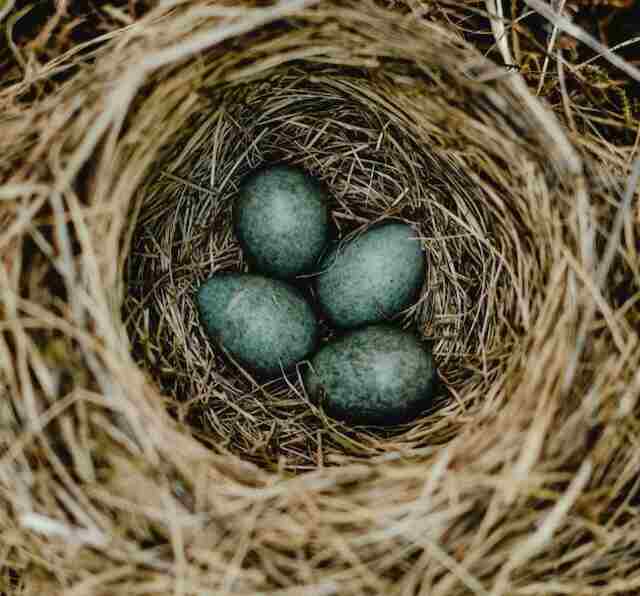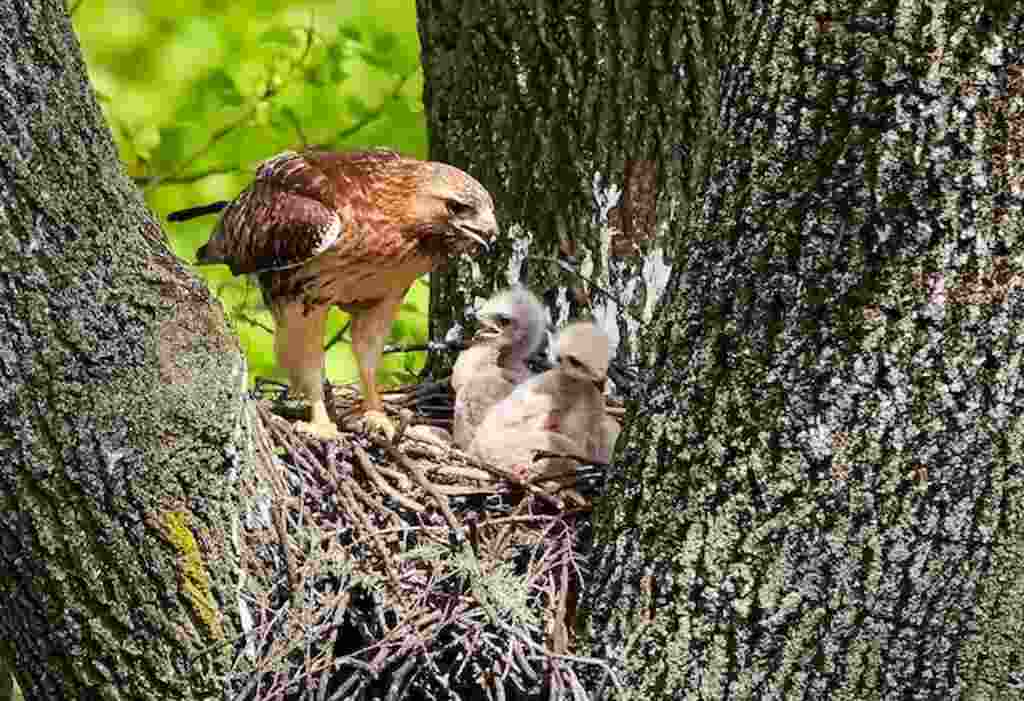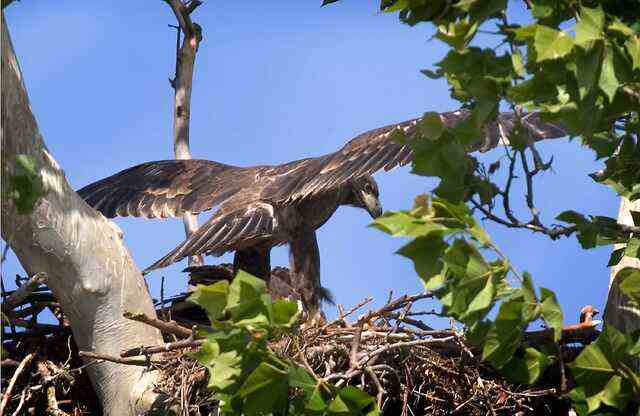Have you ever wondered how long mother birds leave their nests? The answer varies depending on the species and other environmental factors. In this article, we will explore the duration of mother bird presence in the nest, their nesting behaviors, and the importance of nest survival for bird offspring.
The survival of bird offspring heavily relies on the quality of their nest, and the care provided by their parents. If a nest fails, young birds may suffer from exposure, starvation, or predation.
Therefore, understanding how long mother birds leave the nest and their nesting habits is crucial for the survival of avian populations.
Table of Contents [show]
Key Takeaways:
- Mother birds typically leave the nest after a few weeks.
- The duration of mother bird presence in the nest depends on various factors, including environmental conditions, predation risk, and food availability.
- The dedication of mother birds in providing parental care is crucial for the survival of bird offspring.
How Long Do Mother Birds Leave The Nest?
The length of time that mother birds leave the nest varies depending on the species. In general, most mother birds will leave the nest for short periods of time to gather food or take a quick break.
However, the amount of time they are away from the nest can range from a few minutes to several hours. Some species, such as albatrosses and penguins, may leave the nest for days or even weeks at a time to forage for food.
It’s important to avoid disturbing bird nests during this critical period, as interference can cause the parents to abandon their young. If you find a baby bird on the ground, it’s best to leave it alone and let the parents continue to care for it.
Understanding Bird Nesting Behavior
Birds are known for their fascinating nesting behavior, which involves a complex set of behaviors aimed at ensuring the survival of their offspring. Both male and female birds contribute to nesting and parenting, with the female typically taking the lead in nurturing the eggs and chicks.
At the start of the nesting period, the female bird constructs a nest using various materials, such as twigs, grass, and leaves. The location of the nest varies depending on the species, with some birds nesting on the ground, in trees, or in burrows.
Once the nest is complete, the female will lay her eggs, with the number of eggs varying between species.
| Example Egg Clutch Sizes of Popular Bird Species | Species | Clutch size |
|---|---|---|
| Small songbirds | Blue jay | 4-7 eggs |
| American robin | American robin | 3-5 eggs |
| Woodpecker (medium-sized bird) | Downy woodpecker | 4-5 eggs |
| Medium-sized birds | House finch | 4-5 eggs |
| Larger birds | Bald eagle | 1-3 eggs |
Once the eggs are laid, the female bird begins the incubation process, during which she sits on the eggs to keep them warm and ensure their survival. The length of the incubation period varies between species, but typically lasts between 10 and 50 days.
During this time, the male bird will assist with the incubation process, bringing food to the female while she sits on the eggs in the nest.
After the eggs hatch, the chicks are completely dependent on their parents for food and care. The mother bird continues to provide dedicated parental care during this stage, feeding and protecting the chicks from predators, while the father bird brings food to the nest.
As the chicks grow and develop, the mother bird gradually reduces her presence in the nest, allowing the offspring to become increasingly independent.
Roles of Male and Female Birds in Nesting and Parenting
While the female bird takes on the primary role of incubating the eggs and caring for the offspring, the male plays a crucial role in supporting the nesting process. In some species, such as swans and geese, the male bird will even help construct the nest itself.
The male bird is also responsible for providing food for the female during the incubation period, as well as both parents contributing to feeding the chicks after they hatch. As the chicks grow and develop, the male bird may take on greater responsibility for feeding and caring for them.
Overall, the nesting and parenting behavior of birds is a remarkable example of dedication and cooperation between both parents. As the offspring grow and become more independent, the parents gradually reduce their presence in the nest, allowing the young birds to develop the skills necessary for survival in the wild.
Initial Nesting Period
Once mother birds lay their eggs, they typically remain in the nest for an extended period. However, they may briefly leave the nest to forage for food or stretch their wings.
The duration of this initial nesting period can vary widely between species, ranging from just a few days to several weeks. Factors that influence the length of this period include the size and number of eggs in the nest, the bird’s metabolic rate, and the availability of food.
While mother birds are typically very dedicated to their nests during this time, there are instances where they may temporarily abandon the nest. This may occur if the bird feels threatened by predators, experiences habitat disturbance, or if the eggs become infected. If the interruption is brief, however, the mother bird will often return to the nest and resume her care.

Incubation Period
Once the mother bird has laid her eggs, the next phase of the nesting process is the incubation period. During this time, the mother bird diligently sits on the eggs to keep them warm and ensure their proper development.
On average, the incubation period lasts between 10-14 days, although this can vary depending on the species of bird. Some birds may have a shorter incubation period, while others may have a longer one.
During this time, the mother bird rarely leaves the nest and spends most of her time keeping the eggs at a consistent temperature by adjusting her position and fluffing her feathers. It is crucial for the eggs to stay at a consistent temperature to ensure proper development.
Once the eggs hatch, the mother bird will continue to provide warmth and protection to the young until they are able to regulate their own body temperature and leave the nest.
The incubation period is a crucial time in the development of bird offspring, as it sets the foundation for their future growth and survival.
Feeding and Nest Maintenance
Mother birds are known for their remarkable dedication in providing nourishment to their young, while also ensuring the nest is clean and secure. This harmonious balance is crucial to the survival of the offspring, as it allows them to grow and develop without the added stress of external threats.
During the early stages of development, mother birds spend the majority of their time in the nest, feeding their young and removing any waste or uneaten food. As the offspring grow, the frequency of feedings may decrease, but the mother bird’s presence in the nest remains vital.
In addition to feeding, mother birds also engage in nest maintenance activities. This includes removing any debris or dead prey that may have accumulated in the nest, as well as repairing any damage to the nest structure.
The meticulous care provided by mother birds highlights their profound commitment to the survival of their offspring. By ensuring a clean and secure environment, mother birds create an optimal space for their young to thrive and eventually gain their independence.
Growing Independence
As the offspring grow and develop, mother birds gradually reduce their presence in the nest and shift their focus to providing food and protection.
Young birds typically reach a stage where they are ready to leave the nest and explore their surroundings. This period of increased activity and exploration is known as fledging.
During the fledging period, mother birds will continue to provide food and support to their offspring, but will gradually decrease their presence in the nest. This allows the offspring to gain valuable skills and independence.
Eventually, the young birds will become fully independent and leave the nest. At this point, mother birds may continue to monitor their offspring and provide occasional support, but their primary role in the nesting process is complete.
It is important to observe and appreciate this process of growing independence in mother birds and their offspring. By doing so, we can gain a greater appreciation for the remarkable dedication and care exhibited by mother birds throughout the nesting process.
Species Variations
While the duration of mother bird presence in the nest is typically influenced by internal and external factors, it is also important to note that different bird species exhibit unique nesting behavior. For instance, some species such as bald eagles can remain in the nest for up to 16 weeks before becoming independent, while others such as barn swallows may only spend three weeks in the nest.
Some species have also evolved distinct parenting strategies. For example, the mother and father of emperor penguins take turns incubating the egg, with the mother returning to sea to feed while the father remains on the nest, a behavior known as bi-parental care. On the other hand, some bird species engage in cooperative breeding, where the offspring are raised by a group of adults.

Environmental Factors
The survival of a bird’s nest is significantly influenced by the environment. External factors such as predation risk, weather conditions, and food availability can impact the duration of mother bird presence in the nest, ultimately affecting the survival of the offspring.
Predation risk is one of the most significant threats to bird nests. Nest predators such as snakes, raccoons, and squirrels can easily access and destroy nests, leading to nest abandonment and the loss of offspring. Weather conditions such as heavy rain, strong winds, and extreme temperatures can also negatively impact the survival of nests and the health of the offspring.
Food availability is another crucial factor that can impact nest survival. If there is a shortage of food, mother birds may need to leave the nest for longer periods to forage, resulting in less time spent caring for the offspring. This can hinder the growth and overall development of the young birds.
The Impact of Human Activity
Human activity can also impact bird nest survival. Habitat destruction, pesticides, and pollution can all harm bird populations and their nesting habitats, leading to a decline in their overall survival rate. It is essential to protect and preserve natural habitats to ensure the survival of bird species and their offspring.
By understanding the impact of environmental factors on bird nest survival, we can work towards conserving and protecting their habitats and ensuring the survival of these remarkable species.
Observing Mother Birds
Observing mother birds in their natural habitat can be a rewarding and educational experience. It allows us to gain insight into their nesting behaviors and appreciate their dedication and care for their offspring.
To observe mother birds, it is important to approach their nesting areas quietly and respectfully, keeping a safe distance so as not to disturb them. Use binoculars or a spotting scope to observe them from afar, without getting too close.
Take note of their behavior, such as how often they leave the nest to search for food and how they interact with their young. You may even witness the young birds leaving the nest and taking their first flights.
It is important to remember that mother birds may abandon their nests if they feel threatened or disturbed, so always prioritize their safety and well-being above your desire to observe them.
Through observing mother birds, we can learn more about their nesting behaviors and the importance of protecting their habitats to ensure their survival.
Conclusion
In conclusion, mother birds typically leave the nest for varying durations depending on the species and environmental factors. However, on average, they tend to remain in the nest for about two weeks after the eggs have hatched.
During this time, mother birds exhibit remarkable dedication and care in feeding and maintaining the nest. Understanding bird nesting behavior and the factors that influence nest survival is crucial for appreciating the importance of birds in our environment.
By observing mother birds in their natural habitat, we can learn more about their unique parenting strategies and the remarkable lengths they go to ensure the survival of their offspring.
It is imperative that we continue to conserve bird habitats, as external factors such as predation risk, weather conditions, and food availability can have a significant impact on the duration of mother bird presence in the nest.
By doing so, we can help ensure that future generations can appreciate the beauty and wonder of these remarkable creatures. Thank you for reading this article, and we hope it has provided valuable insight into the fascinating world of mother birds.

FAQs: How Long Do Mother Birds Leave The Nest?
How long do mother birds typically leave the nest?
The duration that mother birds leave the nest can vary depending on the species and environmental factors. On average, mother birds may leave the nest for short periods of time, ranging from a few minutes to a couple of hours, to forage for food or take a break.
What factors influence nest abandonment?
Nest abandonment can be influenced by various factors, including predation risk, disturbance, and availability of food. If the nest is compromised or the environment becomes unsuitable, mother birds may abandon the nest altogether.
How important is nest survival for bird offspring?
Nest survival is crucial for the survival and development of bird offspring. The nest provides a safe and protected environment for the eggs and young birds, shielding them from predators and harsh weather conditions. A successful nest ensures the best chance of survival for the offspring.
What is the nesting behavior of birds?
Birds exhibit various nesting behaviors, with both parents often playing a role in caring for the nest and eggs. Mother birds are particularly dedicated to providing parental care, which includes incubating the eggs, feeding the young, and maintaining the nest.
How long do mother birds typically remain in the nest once they have laid their eggs?
The initial nesting period can vary among different bird species, but on average, mother birds tend to remain in the nest for a few weeks after laying their eggs. During this time, they incubate the eggs and ensure their proper development.
How long is the incubation period?
The incubation period typically lasts for a few weeks, during which the mother bird diligently sits on the eggs to keep them warm and facilitate the hatching process.
How do mother birds balance feeding their young and maintaining the nest?
Mother birds have a remarkable ability to balance feeding their young and maintaining the nest. They alternate between foraging for food and returning to the nest to feed their offspring. They also engage in nest maintenance activities such as removing waste and repairing any damage.
How do the young birds become independent and leave the nest?
The process of the young birds becoming independent and leaving the nest is gradual. As the offspring grow and develop the necessary skills for survival, mother birds gradually reduce their presence in the nest. Eventually, the young birds venture out on their own, exploring their surroundings and practicing their flying and foraging abilities.
How do different bird species vary in their nesting habits and nest duration?
Different bird species exhibit varying nesting habits and nest duration. Some species build intricate nests that can last for several years, while others construct simpler nests that may be used for a single breeding season. Each species has its own unique parenting strategies and timelines.
How do environmental factors impact nest survival and the duration of mother bird presence in the nest?
Environmental factors such as predation risk, weather conditions, and food availability can significantly influence nest survival and the duration of mother bird presence in the nest. Adverse conditions or reduced food availability may force mother birds to abandon the nest earlier than expected.
How can I observe and appreciate mother birds in their natural habitat?
To observe and appreciate mother birds in their natural habitat, it is important to minimize disturbance and maintain a safe distance. Use binoculars or a spotting scope to get a closer look without disturbing the birds. Observe their behaviors and nesting activities while respecting their space.




